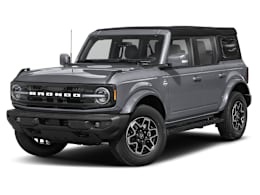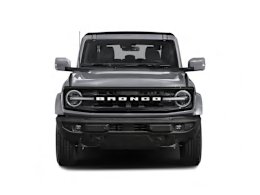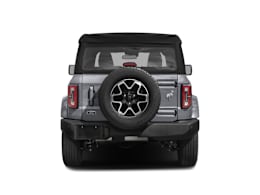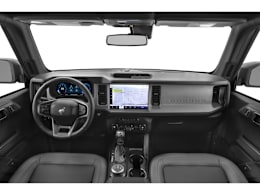The resurrected Bronco has clearly been designed to compete with the iconic Jeep Wrangler. We found the boxy Bronco to be a superior daily-driver to the Jeep in many ways, with better handling and a more comfortable ride, yet like the Jeep it’s an immensely-capable off-roader. Unusually long stopping distances in our testing, underwhelming fuel economy, and elevated wind noise compromise its road-test score compared to most other mainstream two-row midsized SUVs, although it’s competitive when viewed against off-road-capable models such as the Toyota 4Runner, Land Rover Defender, and Wrangler.
We tested an Outer Banks trim with the optional 315-horsepower, 2.7-liter turbocharged V6. This engine provides plenty of giddyup, including a gutsy midrange punch, and the Bronco galloped from 0 to 60 mph in 7.0 seconds, which is pretty quick for such a heavy SUV. The 10-speed automatic transmission upshifts smoothly, but some downshifts come with a slight jolt. Fuel economy was less impressive, the Bronco managing just 18 mpg overall in our testing. A 2.3-liter turbocharged four-cylinder that produces 275 hp comes standard, available with either a seven-speed manual transmission or the 10-speed automatic. All Broncos come with four-wheel drive.
Despite its burly body-on-frame construction and suspension designed with off-roading in mind, the Bronco rides reasonably well, only feeling overly stiff and jiggly on bumpy back roads. Handling agility isn’t a strong suit, but it tracks better in a straight line than the wandering Wrangler, and it was predictable and forgiving—albeit with low limits—when pushed hard around our test track.
However, the Bronco’s stopping distances are among the longest we’ve seen from any vehicle in years. It needed 149 feet to stop from 60 mph on dry pavement, and 168 feet in the wet. Those distances are longer than with some full-sized pickup trucks.
As expected, off-road ability is a strong suit. Even our Outer Banks trim, which is more on-road-oriented than other Bronco versions, handily scaled our challenging rock hill, thanks to generous suspension travel and ground clearance, short overhangs front and rear, and a locking rear differential. The Bronco’s front trail camera makes it easy to point and place the front tires where you want them to help get over obstacles cleanly. The navigation system comes with trail maps powered by Ford's Sync 4 infotainment system.
Like the Wrangler, the Bronco comes in two- and four-door configurations, with a standard soft top and an available removable hardtop, and all versions have removable doors. Also like the Wrangler, wind noise becomes quite pronounced above 50 mph. The rustic-themed cabin features many fun details, such as Bronco-specific digital graphics on the instrument cluster and infotainment screen, and several easter-eggs scattered about that remind owners that the original Bronco dates back to 1966. Most controls are fairly user-friendly, but the window buttons and mirror switches are placed in an awkward location on the center console, rather than on the doors as in most vehicles.
The front seats are fairly basic, but their wide shape proved comfortable for most of our drivers. We appreciate the two-way-adjustable lumbar support as well as the ability to tilt the leading edge of the driver’s seat bottom cushion up and down to dial in leg support. The rear seat is relatively spacious, with lots of headroom and good knee room, but the seatback is too upright for long-haul comfort, and the bottom cushion could use more thigh support.
Forward collision warning and automatic emergency braking with pedestrian detection are standard. Blind spot warning, rear cross traffic warning, lane departure warning, and lane keeping assistance are optional.


























